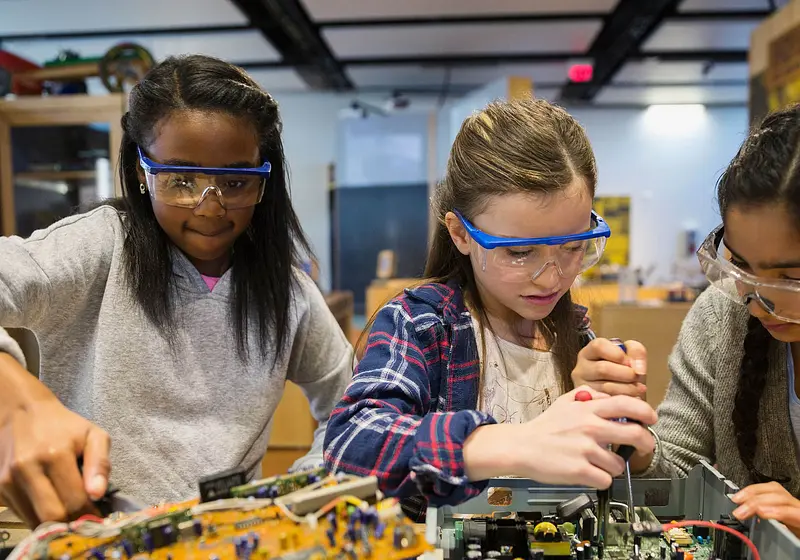Close your eyes and imagine a scientist.
Chances are you envisioned a white man, maybe in a lab coat or holding a beaker. If so, this seemingly innocent test has revealed the internalized belief you hold that males belong in science, technology, engineering, and mathematics (STEM). At the same time, females should seek careers for social good, like becoming teachers and nurses. The Girls in STEM movement aims to fight these gender biases in the workforce, envisioning women as leaders of STEM advancements.
Gender Biases
Stigmas doubting women's intelligence and abilities have been used to justify gender biases throughout history, with prejudices still evident in modern society. In schools, the majority of teachers are females, and they are often subconsciously stricter with girls in STEM subjects, causing these children to believe they are dumber than male students. Meanwhile, in classes like visual and language arts, teachers are harsher on the boys.
As these kids experience more gender biases with age, boys believe they are better at STEM, and girls think they are stronger at subjects requiring creativity, with society perpetuating this. Many girls become teachers and push the stigmas that were forced on them onto their students, creating a cycle.
This idea is reinforced by girls only having a few females in STEM to look up to in real life and the media. Girls of color have even fewer role models, and they experience both racial and gender discrimination. Additionally, because of racial and economic disparities, they are more likely to live in poor communities with lower accessibility to and quality of education.
For the girls who do enter STEM, they face further obstacles. A study at Yale University had scientists review applications of males and females with the same credentials, but they consistently rated the male applicants as more proficient. This shows the greatest barrier females in STEM face: their abilities are hidden by their gender.
If you are a girl, you have likely had many of these experiences, and you might not have been aware of some of them because of how normalized they are. Even if you are not female, you face the effects of these stigmas. For example, education is labeled as an easy field because it is female-dominated. Hence, males interested in it are often urged to do something more "reputable," whereas females are encouraged to become educators.
Girls in STEM Movement
Rapidly growing, the Girls in STEM movement aims to increase the accessibility and quality of resources for STEM education for girls. It has been incredibly successful: in 1970, women made up eight percent of the fields, but as of 2019, this number has risen to twenty-seven percent. However, this movement is about more than changing a statistic. It is changing the narrative of what girls can do.
One way it does this is by creating clubs for girls in STEM, from elementary schools through colleges. Within these, members are given educational resources to help them excel, learning essential skills like leadership and confidence. Some organizations offer lessons to STEM educators where they can learn how to detect and avoid implicit gender biases and to make content more appealing to girls.
If you reflect on the science classes you have taken, you likely have primarily learned about male scientists. While women were not given access to educational resources in history, causing men to lead in the fields, they have made phenomenal achievements that have been discredited and undermined. These organizations work to change this, starting in classrooms.
Importance of Girls in STEM
Feminism is the belief that males and females should be treated equally in all aspects, and concrete action should be taken to achieve this. The Girls in STEM movement is an important branch of this, as it advocates for economic and social equality, supporting other feminist movements.
Furthermore, STEM is made up of essential fields. They are driving change in society and making life-saving breakthroughs. Increased female participation would bring more diversity to research, allowing for a greater range of advancement.
In medicine, for example, there is inadequate understanding of female bodies, especially those of color, as it is a male-dominated field. Women in medicine not only make female patients feel more comfortable and seen but also offer their experiences for increased research.
This will additionally help with the current shortage of STEM professionals, as men are already entering the fields at a higher rate than ever before but cannot meet the growing demands as we tackle pressing issues like climate change.
"Women comprise about half of the world’s population, and we only have about half of the STEM professionals that we need. Thus, the answer to the shortage of STEM professionals is clear– we need more women in STEM."
- Built By Me, STEM Education Platform
The movement is not only focused on females, however. An important aspect of it is encouraging males to enter socially-good fields, justifying the importance of these. By people having jobs they are truly passionate about, we can accomplish so much more.
What You Can Do
While we have made progress, there is so much that needs to be done. As teens, we are the future. The world needs our change, so here's how you can start:
1. Encourage girls to pursue STEM.
One way you can do this is by starting a club in your school like those aforementioned to foster a community where girls motivate each other and gain the confidence to find their places in a world designed for males.
2. Support Girls in STEM organizations.
This can be done by informing others about these and donating.
3. Advocate!
Fight for the increased quality and accessibility of STEM education for girls starting in early education, full enforcement of Title IX (law prohibiting gender discrimination) in STEM jobs, pay equity, and similar pressing issues. You can do this through social media, protests, fundraisers, and petitions, among others. Get creative!
4. Be a good role model.
This is a must if you have a close relationship with a young girl, especially if she is of color. If you are not interested in STEM, introduce her to role models who are. From enrolling her in science summer camps to math after-school clubs, show her what she is capable of.
Summary
Because of how sexism and racism are ingrained into our world, females face barriers that cause them to enter STEM fields at significantly lower rates than males. Working with other feminist movements, the Girls in STEM campaign breaks gender disparities to increase diversity in science and mathematics. It needs us to inspire and pave the path for the next generation, proving their gender does not affect their abilities. If we unite to accomplish this, one day, when asked to imagine a scientist, people will see a powerful woman with textured hair and colored skin.




